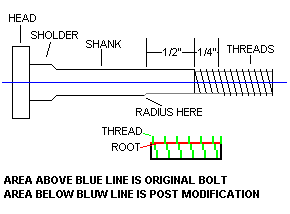Matt's Old Cars.com
Fiddling with Rambler's since 1995
Project Charity: AMX
Technical Information
Photo Gallery
Rambler American Restoration
1978 El Camino
1967 Rambler American
2007 Dodge Ram
1984 Dodge Ramcharger
Links
FAQ
Send me an e-mail:
Contact Form
Back to American Restoration Index
Head Bolt Modification
Just like every other car company, AMC made its share of mechanical blunder's. One of the biggest problems they seemed to have in the 60's was finding engine designers that understood the fact that engines tend to last longer if all of the moving parts get a decent oil supply. Luckily for us straight six guys, we can fix our oiling problem (if its caught soon enough) without pulling the engine from the car.
There are a couple of catches with what this simple modification will fix.
- It only applies to 199 and 232 sixes made before 1971 with shaft type rocker arms. The shaft rocker arms were also used a few years in the mid-70's but the oiling system was fixed by then.
- If the engine has low oil pressure, this is not a "magic bullet" type fix. You need to have a steady 13psi at idle and approximately 10psi more for every additional 1000 rpm. If you don't meet this criteria, you're engine probably has bad bearings or an oil pump problem. Check oil pressure with a mechanical gauge.
The problem with the oiling system on these engines lies in the fact that the oil passage leading to the rocker shaft gets reduced to 1/16" where one of the head bolts passes through it. This small passage is actually big enough to get a decent amount of oil to the valve train as long as it is clear. The problem was that not everyone is as diligent about oil changes as we are and the oil available in the 60's was not as stable as it is now. This lead to sludge problems and once that little passage way is plugged up, you get no oil to the valve train. The worst thing about this is that by the time the engine starts making funny noises, the rocker arms, shaft, and valve guides are chewed up.
AMC, most likely annoyed at the results of this problem, issued a TSB (Technical Service Bulletin) on 12/21/1967 detailing how to fix this problem. There were two different fixes authorized by the factory for this. The second fix, which I'm not going to detail, involved running an external oil line to the rocker shaft. This was an extra cost item available under part #8120298. (Note: As of 12/29/1998, one of these is still available. You can find it at http://www.partsvoice.com by searching under Chrysler for part J8120298). The other fix was a modification that removed some material from the head bolt that passes through oil the passage.
| To do this modification, you'll
need to remove the 3rd from the rear passenger side head bolt (make sure the
motor is completely cold) and the 2nd from the rear rocker shaft screw. Insert
a stiff wire into the oil passage starting at the rocker shaft (it will take a little
patience to get the wire in the right spot since you can't see the passage) to break up
any sludge in the passage and then blow it out with compressed air. Once the passage is clear, modify the head bolt as shown in Figure A. What you are doing is removing the top 1/4 inch of threads and the bottom 1/2 inch of the shank down to the root diameter of the threads. The root diameter, for those of you who don't know, is the valley portion of the threads (show as the red line in Figure A). Once these areas are cut down, you MUST radius the area between the original diameter shank and the smaller diameter shank you just created. Failure to do this will weaken the bolt to the point where it may break at this point during engine operation. This modification adds almost 1/8th of an inch to the oil passage. |
Fig A- sketch showing how to modify the head bolt |
Once the bolt is modified, re-install it and torque to 80-85 ft/lbs. Re-install the rocker shaft bolt and torque it to 20-23 ft/lbs.
Before you re-install the rocker cover, make sure to inspect the rockers and shaft for scoring and the valves for excessive play in the guides. If the shaft is scored, I recommend getting a rebuilt rocker assembly (rebuilt arms, new shaft) from Kanter Auto Products (http://www.kanter.com). If the valves have excessive play, you'll need to remove the head and have new guides installed.
Once this is done, check the engine to make sure oil is now getting to the rocker shaft assembly. If its not, the problem is likely caused by worn bearings (usually the cam bearings since the oil feed hole is pressurized from one of them). The only way to cure this is to replace all of the engine bearings which usually means a rebuild since the engine is torn down to that level.
Last Updated 01/05/04 09:11:01 PM
